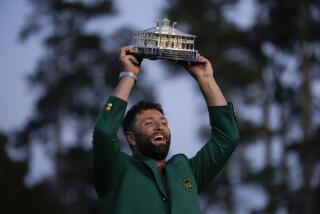Sarazen Made It a Stroke of Genius
- Share via
AUGUSTA, Ga. — The most famous shot in the history of the Masters . . . no, in the history of golf, turned 62 on Monday, brought to us by someone who came into this world christened Eugene Saraceni but decided to change his name because it sounded too much like the name of a violinist.
It probably was a good idea, because Gene Sarazen didn’t play golf like a violinist. He played more like a tympanist, using a style that was straightforward and simple but still capable of producing music.
Sarazen is 95 and lives on Marco Island, Fla., but he vows he will be there on the first tee today at Augusta National to strike the ceremonial first ball at the 61st Masters. It is only fitting.
For in 1935, Sarazen did something to put the fledgling tournament--known then, in its second year, as the Augusta National Invitational--on the map.
Sarazen made history with a single shot from the fairway and in so doing made Bobby Jones’ tournament something more, something grand, something called the Masters. The tournament had been called that unofficially, but Jones had rejected that title as pretentious. After Sarazen’s historic shot, there was no holding back the tide.
Standing over his second shot on the 485-yard, par-five 15th hole, Sarazen trailed Craig Wood by three strokes on the last day of the tournament.
With 235 yards to the hole, Sarazen swung his four-wood and sent the ball toward the green, hoping to clear the water in front. It did. The ball landed on the far bank of the water hazard, rolled onto the green and then straight into the hole.
He had made two on a par-five--a double eagle.
One of the spectators at the green just happened to be Jones, who had just happened to stop by to watch. To this day, Sarazen wishes he could have seen the ball drop.
“I couldn’t see that far,” Sarazen said. “All I could see was the people jumping up. It was a lucky shot. I was playing for position, you know. I usually didn’t hit [a four-wood] that far, but I had to be pumped up. When you hole a shot out like that, it’s luck. It’s not something you expect to get. There’s a lot of luck in golf.”
Luck, fate, whatever it was, Sarazen’s double eagle changed everything, including the outcome of the 1935 Masters.
As Sarazen prepared for his second shot on No. 15, Wood already was in the clubhouse with a 73 that had given him 282, six under par. Sarazen, 33, paired with 42-year-old Walter Hagen, had virtually no chance, since he needed to make up three shots in the last four holes to tie.
As it turned out, Sarazen needed only one hole to do it.
Former Chicago Tribune golf writer Charles Bartlett, who then was covering the Masters for the Associated Press, wrote about Sarazen’s double eagle in Golfing magazine in 1965, the 30th anniversary of the shot.
Bartlett quoted Sarazen’s description of the event:
“I hit what I thought was a good drive, about 250 yards, but got a jolt when I found it in a very close lie. My caddie, Stovepipe, and I debated on using a three-wood or a four-wood. We figured the three-wood, somewhat deeper in the face than the four-wood, would never get the ball up from this tight lie. . . .
“I knew the only way I could reach the green with the four-wood was to toe the club in to decrease the loft and so give me extra yardage. The instant I hit it, I knew it would carry the pond fronting the green. The ball lit on the tongue of the green and ran toward the hole.
“While I was straining to see how it finished, the folks around the green let out a terrific shout, then began to jump wildly in the air. I knew then the ball had gone in the hole!”
Jones wrote his own comments about Sarazen’s shot years later for his popular guide for Masters spectators.
“Others have holed out long approaches, but never when it meant so much,” Jones wrote. “This is the golf shot that was said to have been heard around the world. The cheer that went up might well have been.”
If so, the spectators were clearly a hearty bunch, since there were no more than a dozen in the gallery at the 15th at that moment.
Sarazen played the last three holes in even par for a 70, equaling Wood’s total of 282 and forcing a 36-hole Monday playoff. It was not an altogether popular turn of events, Sarazen said.
“The tournament was all wrapped up, they were all going home,” he said. “The sportswriters had all written their stories. They had their little box all finished. They didn’t think too much of it . . . having to stay over another day.”
Sarazen and Wood played 36 more holes Monday, Sarazen shooting 144 to Woods’ 149. If you count his four practice rounds, Sarazen played 180 holes at Augusta National that week. What’s more, he never took more than a five on any hole. For his efforts, Sarazen earned $1,500.
Charles Price, in his book “A Golf Story: Bobby Jones, Augusta National and the Masters Tournament,” wrote that Sarazen’s shot occurred at the right time--the depths of the Depression--to capture the interest of the American public, which enhanced the lore.
“It would be hard to choose a year in the country’s history when Americans were more eager to accept the element of luck, not just in sports, but in almost anything,” Price wrote. “ . . . The nation had sunk to an emotional low point. It was without hope in the land of promise, without faith in the hard work that had made it so.
“The game of golf didn’t have much to offer the man on the street, especially now that Bobby Jones was no longer performing the impossible. But it could offer up Eugene Saraceni, the son of an Italian immigrant, making a golf shot that was 40,000-1. That it happened on Bobby Jones’ course and during his tournament--well, there was hope yet, some things you could still have faith in.
“Sarazen’s double eagle didn’t make the front pages, but it came at a time when people would welcome anything lucky, anywhere they could find it, in the sports pages if they had to and about golf if they must, the closer to the impossible the better.
“Gene Sarazen’s double eagle qualified as ‘impossible.’ ”
It may have been circumstance that Sarazen became a golfer in the first place. His father was a carpenter who had studied for the priesthood in Italy and was opposed to young Gene’s career in golf. But Sarazen got pleurisy when he was working as an apprentice for his father in Connecticut and doctors advised him to try less strenuous work. While he was recuperating, Sarazen took up golf at a public course and was good enough that he soon was awarded a job as an assistant.
In 1922 at 20, Sarazen won the U.S. Open and then the PGA Championship months later. He would win the PGA again in 1923, his second U.S. Open in 1932 and the British Open the same year. All the titles afforded Sarazen great renown, but they could not compare to the four-wood double eagle that brought him the 1935 Masters.
The 15th at Augusta has since been lengthened to 500 yards. But if you stand in the same position on the fairway where Sarazen stood, 235 yards from the hole, the perspective is unchanged 62 years later. It’s still a long shot.
More to Read
Go beyond the scoreboard
Get the latest on L.A.'s teams in the daily Sports Report newsletter.
You may occasionally receive promotional content from the Los Angeles Times.










